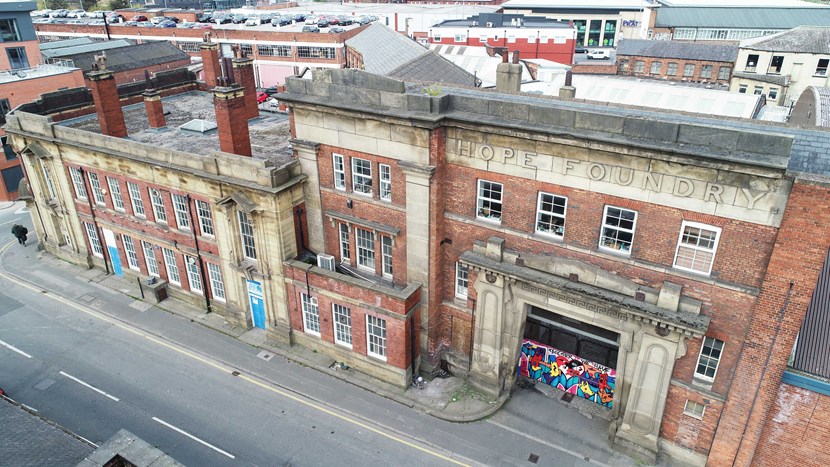
25 Mar 2022
Join the conversation about conservation and help shape Mabgate's future
People in Leeds are being encouraged to have their say on newly-announced plans to create a conservation area in one of the city’s most historic and characterful neighbourhoods.
The proposed Mabgate conservation area would aim to protect and enhance heritage assets while also helping ensure that future development work respects the district’s existing architecture as well as the strong sense of identity that runs through its buildings and streets.
Covering just over 10 hectares, the conservation area would be bounded to the west by Regent Street, to the north by Mushroom Street, to the east by Macaulay Street and to the south by New York Road.
Mabgate’s position on the edge of the city centre means it offers major potential for new growth and, with that in mind, Leeds City Council is keen to take steps to protect important aspects of local heritage as development proposals come forward.
A public consultation has now been launched on the conservation area plans, with information leaflets due to go out shortly to residents, businesses and other occupiers in Mabgate.
The plans have been drawn up by the council in collaboration with Leeds Civic Trust, which has provided funding for the project, and expert heritage architects Purcell.
With a proud history as one of the original drivers of the city’s industrial and manufacturing revolution, Mabgate has in recent years been transformed into a rich and diverse community with a thriving independent arts scene.
Local landmarks include Mabgate Mills, St Patrick’s Church and Hope Foundry, a Grade II-listed former brass and iron works.
Details of the conservation area project have been announced as work continues on a regeneration framework that will lay out – following months of conversations with residents, businesses and other stakeholders – an action plan and shared set of ambitions for the future of Mabgate as a whole.
The new proposals also tie in with the emerging East Street Arts-led neighbourhood plan for Mabgate, Lincoln Green and Burmantofts, which is designed to help chart a course for future development in those three areas.
The conservation area, the regeneration framework and the neighbourhood plan are separate initiatives but are intended to complement each other and provide a hugely-positive platform for growth in Mabgate and the surrounding districts.
Changes already under way in Mabgate include a bike and pedestrian-friendly reshaping of local street designs as part of the council’s Mini Holland highways scheme. Work on the Regent Street flyover, meanwhile, is delivering better connections between Mabgate and the city centre, with increased scope for the creation of attractive public space.
Councillor Helen Hayden, Leeds City Council’s executive member for infrastructure and climate, said:
“Mabgate is a place with a fascinating story to tell, from its industrial past to its more recent reinvention as an endlessly-creative hub for arts and cultural activity.
“We want to make sure the inclusive and compassionate growth we are seeing – not just in Mabgate but across the city as a whole – takes proper account of Leeds’s shared heritage and historic values.
“I would encourage everyone to get involved with the public consultation and help shape the future of this much-loved community.”
Martin Hamilton, director of Leeds Civic Trust, said:
“When Leeds Civic Trust first suggested that we could help Leeds City Council to develop the city’s network of conservation areas by providing our own funding and expertise, we agreed that the Mabgate area of Leeds should be the first port of call.
“There is a new dynamism in the area with new buildings proposed and new occupiers coming forward.
“We hope that the designation of a conservation area will enable these exciting changes to take place in a way that respects what is already there.”
Designating an architecturally or historically significant place as a conservation area hands councils extra controls over planning matters such as demolition and development.
The Mabgate proposals can be viewed online here or found by visiting www.leeds.gov.uk and typing ‘conservation area’ into the search box.
Feedback can be sent by e-mail to building.conservation@leeds.gov.uk or posted to Conservation Team, Leeds City Council, Merrion House, Leeds LS2 8BB. The consultation runs until Friday, April 22.
As well as asking people if they support the idea of a Mabgate conservation area, the consultation is seeking views on what would need to be included in an associated appraisal and management plan.
If the conservation area gets the go-ahead, the appraisal and management plan would be used in the determination of relevant planning applications and appeals.
Leeds currently has a total of 80 conservation areas, with the first – in Boston Spa – being designated in 1969, and the most recent – covering the city centre’s Grand Quarter – coming into force in 2017.
ENDS
For media enquiries contact:
Leeds City Council Communications team
communicationsteam@leeds.gov.uk